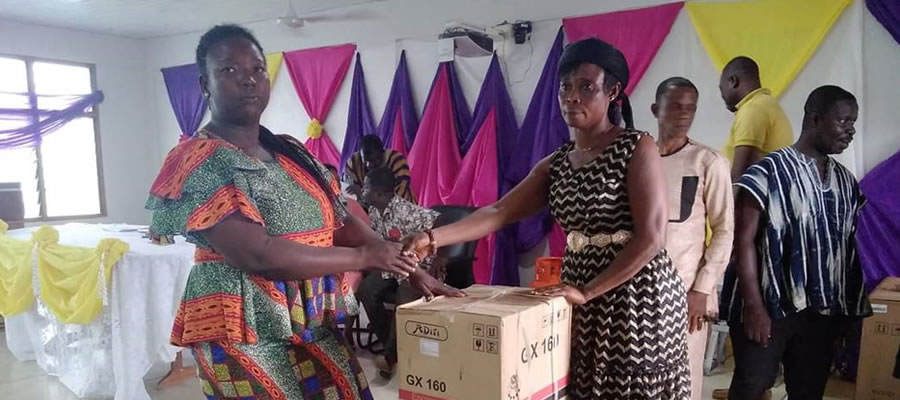

Main Source of Water for drinking and for other Domestic Use
Main source of drinking water
The main sources of drinking water in Sefwi Akontombra are presented in Table 8.10. Household drinking water is obtained from six main sources: river or stream (46.5%), bore-hole including pump or tube well (25.0%), pipe-borne water outside the dwelling (6.8.0%), public tap or standpipe (4.6%), pipe-borne water inside the dwelling (0.3%) river and sachet water (1.1%).
The main source of drinking water for both rural (46.2%) and urban (49.5%) areas is rivers/streams. This is followed by water from borehole/pump/tube well which used by 20.3 percent urban and 25.5 percent rural households. Pipe-borne water (inside dwelling and outside dwelling) had a cumulative proportion of 4.7 percent for urban and 7.3 percent for rural households. The proportion of dwelling units that use sachet water for drinking is 9.1 percent in urban areas and 0.3 percent for rural households.
Main source of water for other domestic use
Quality water for domestic use is essential for the health of members of households. Table 8.10 shows information on main source of water for other domestic use of household. A high percentage of households use rivers/streams (52.5%). This is followed by bore-hole/pump/tube having a proportion of 20.8 percent. Public tap/stand pipe recorded a low percentage of 3% for the entire district. Households using Pipe-borne water inside dwelling and outside dwelling constitute a proportion of 6.4 percent. In the urban and rural areas of the district, more than 50.0 percent of households (59.4% and 51.9% respectively) use river/stream water for other domestic purposes. Some households in the urban and rural areas use water from unprotected well (4.3% and 8.5%) and unprotected spring (0.3% and 0.9% respectively) for other domestic purposes.
Bathing and Toilet facilities
Toilet facilities by locality.
Information on toilet facilities is important for housing as well as public health policy and for planning the location of such facilities in areas they are most needed. Table 8.11 shows type of toilet facilities by locality in Sefwi Akotombra District. Pit latrine is the most prevalent type of toilet facility used by the households in the district, accounting for 61.4 percent. Public toilet (WC/KVIP/Pit pan, etc.) is second type of toilet facility used by households (30.2%). About 5.0 percent have no toilet facilities (bush/beach/field)
More rural (63.4%) than urban (40.8%) households use pit latrine in the district. The proportion of households which use public toilet (WC/KVIP/Pit pan, etc.) is higher in urban (37.3%) than rural (29.5%) areas. Some proportions of households in urban (6.8%) and rural (4.9%) areas in the district have no toilet facilities; they use the bush or beach or field.
Table 8.11 shows that almost half (48.5%) of all the households in the district use their own bathrooms, followed by 22.3 percent which used shared separate bathrooms within the same house with other households. Households that have their bath in open space and around the house are the third largest percentage-11.9 percent. Households using a bathing facility in another house are next, constituting 8.1 percent. About two in every three urban households (44.3%) use shared separate bathroom in the same house with other households, 18.2 percent have their own bathroom for exclusive use and 16.6 percent use shared open cubicle while 10.4 percent use bathroom in another house. On the other hand, more than fifty percent (51.5%) of rural households have their own bathrooms for exclusive use, followed by 20.1 percent that share separate bathroom in the same household. The proportions of rural households bathing in open space around the house and in another house are 12.6 percent and 7.9 percent respectively.
Methods of Waste Disposal
Methods of waste disposal are divided into two major categories i.e. liquid waste and solid waste disposals. Waste disposal, especially solid waste, has remained a challenge to many localities in Ghana. Metropolitan, Municipal and District Assemblies (MMDAs) in the last decade have resorted to the use private waste management companies to manage solid waste in communities, especially urban communities.
Solid waste disposal
Table 8.12 shows the methods of solid and liquid waste in the households disposal of by locality. The main method of solid waste disposal most households in the district is public dump (open space) which accounts for 59.6 percent, followed by dumping indiscriminately 27.2 percent. Burying and burning of solid waste is done by a small proportion of households, 4.6 percent and 1.7 percent respectively. Only 3.6 percent of household solid waste is collected in the district. Dumping of solid waste in open space at public dump is most common in urban (71.6%) and rural (58.4%) areas. Solid waste is dumped indiscriminately by 2.1 percent and 29.7 percent urban and rural households respectively. Solid waste is collected for 2.4 percent and 3.7 percent urban and rural households.
Liquid waste disposal
More than fifty percent (55.4%) of households throw their liquid waste onto compounds while 32.7 percent of households throw their liquid waste into the street/outside in the district. Other households throw their liquid waste into the gutter (8.4%) and through the drainage into the pit or soak away (0.4 percent).
Date Created : 11/20/2017 4:32:22 PM








 facebook
facebook
 twitter
twitter
 Youtube
Youtube
 +233 593 831 280
+233 593 831 280 0800 430 430
0800 430 430 GPS: GE-231-4383
GPS: GE-231-4383 info@ghanadistricts.com
info@ghanadistricts.com Box GP1044, Accra, Ghana
Box GP1044, Accra, Ghana